Prepare and Monitor Budgets: SITXFIN004 Assessment Workbook Solution
VerifiedAdded on 2023/06/10
|28
|5070
|304
Homework Assignment
AI Summary
This document provides a comprehensive solution to the SITXFIN004 assessment workbook, focusing on preparing and monitoring budgets within the tourism, travel, and hospitality industry. It addresses various budget types, including cash, cash flow, departmental, event, project, purchasing, sales, wage, and whole-of-organization budgets, detailing their roles and nature. The solution identifies data and data sources required for budget preparation, internal and external factors impacting budgets, and individuals who should contribute to the budget planning process. It also explains cost-volume-profit analysis, information needed for drafting budgets, and the importance of valid, reliable, and relevant information. The document further explores how organizational objectives can be reflected in a draft budget, factors for presenting a budget for assessment and approval, and the reasons for circulating a draft budget to colleagues and managers. Finally, it outlines steps to ensure effective budget negotiation and alignment with organizational policies and procedures.
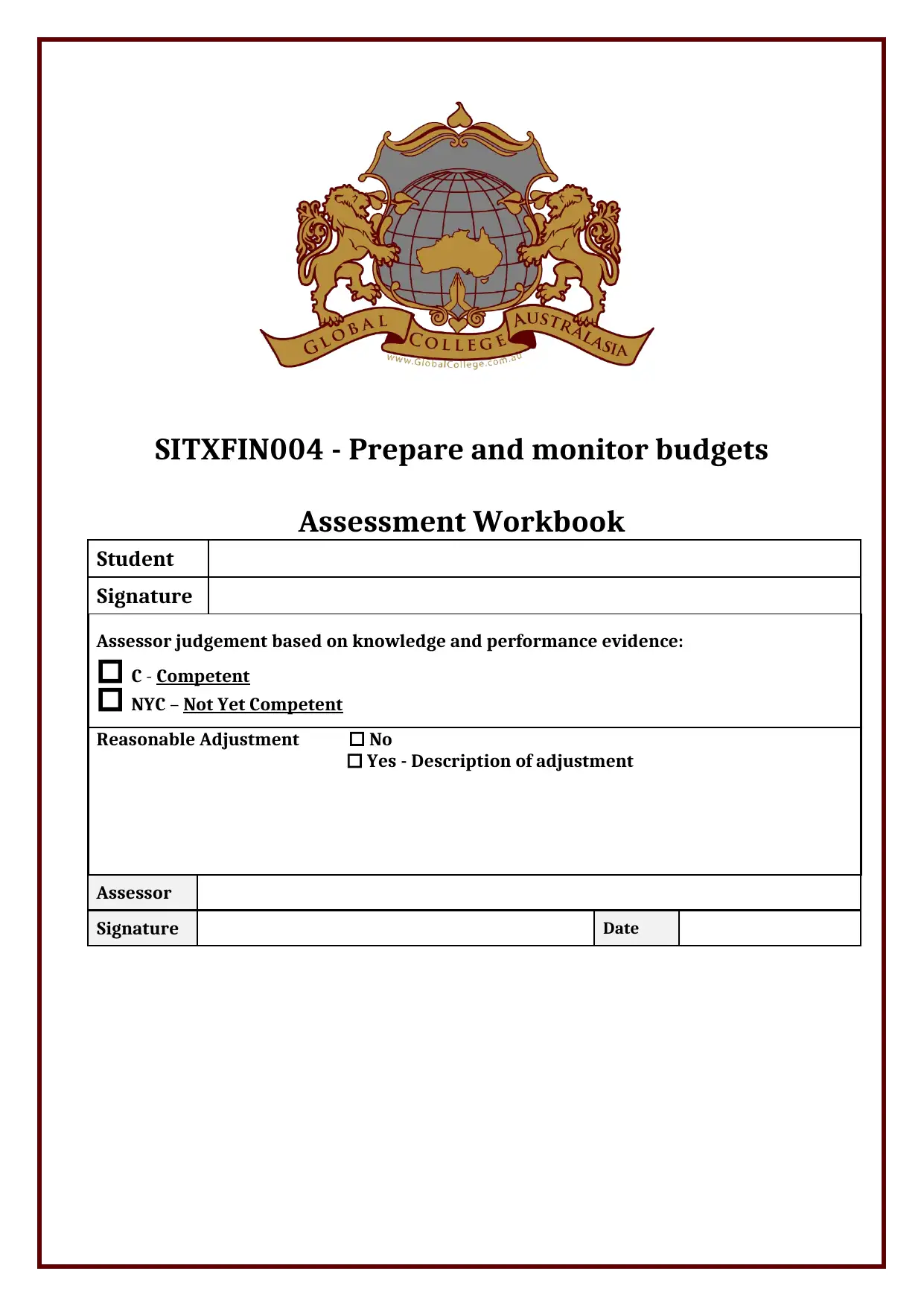
SITXFIN004 - Prepare and monitor budgets
Assessment Workbook
Student
Signature
Assessor judgement based on knowledge and performance evidence:
C - Competent
NYC – Not Yet Competent
Reasonable Adjustment No
Yes - Description of adjustment
Assessor
Signature Date
Assessment Workbook
Student
Signature
Assessor judgement based on knowledge and performance evidence:
C - Competent
NYC – Not Yet Competent
Reasonable Adjustment No
Yes - Description of adjustment
Assessor
Signature Date
Paraphrase This Document
Need a fresh take? Get an instant paraphrase of this document with our AI Paraphraser

Assessment Tool Instructions
This assessment tool is to be completed by the Assessor and the Student. The assessment tool
has been developed to collect and record evidence to assess the Student’s understanding and
application of the performance criteria, performance evidence and knowledge evidence. If
there are multiple units listed above, they have been integrated and are co-assessed
holistically. This assessment tool must be completed using a black or blue pen and all
relevant sections are to be completed.
Instructions to the Assessor
The assessor will provide the assessment tool to the Student and explain the assessment
requirements, providing guidance to the Student as required. Verbal challenging may apply
and the Assessor is required to record these notes in the Assessor’s comments section. Please
ensure that all signatures and dates are accurately recorded, all sections have been marked
and that comments have been included where necessary.
Instructions to the Student
You will be required to read through the assessment activities and prepare for the
assessment. If the assessment involves written responses, you can write your answers in the
spaces under the question. Please ensure that you complete all required sections of the
assessment tool. All questions must be answered in full. Your assessor may verbally challenge
your answer by asking you to clarify or further explain your answer. At the end of this
assessment task, your assessor will provide you with feedback on areas for continuous
professional development. Unless specified, answers should be approximately 100 word in
length.
Before commencing the assessment, please complete the pre-assessment checklist below to
confirm that you, the Student, are ready for assessment.
I have been given access to all of the resources for this assessment YES NO
I have had my rights and the appeal system fully explained to me YES NO
The assessor has discussed special needs assistance with me YES NO
I understand that I have to complete all tasks/questions myself YES NO
I acknowledge that I am ready for an assessment for the unit YES NO
I acknowledge that I have had the assessment process explained to me YES NO
I understand that plagiarism is not accepted YES NO
I agree to undertake assessment tasks in this assessment tool YES NO
16.02.2018 1
This assessment tool is to be completed by the Assessor and the Student. The assessment tool
has been developed to collect and record evidence to assess the Student’s understanding and
application of the performance criteria, performance evidence and knowledge evidence. If
there are multiple units listed above, they have been integrated and are co-assessed
holistically. This assessment tool must be completed using a black or blue pen and all
relevant sections are to be completed.
Instructions to the Assessor
The assessor will provide the assessment tool to the Student and explain the assessment
requirements, providing guidance to the Student as required. Verbal challenging may apply
and the Assessor is required to record these notes in the Assessor’s comments section. Please
ensure that all signatures and dates are accurately recorded, all sections have been marked
and that comments have been included where necessary.
Instructions to the Student
You will be required to read through the assessment activities and prepare for the
assessment. If the assessment involves written responses, you can write your answers in the
spaces under the question. Please ensure that you complete all required sections of the
assessment tool. All questions must be answered in full. Your assessor may verbally challenge
your answer by asking you to clarify or further explain your answer. At the end of this
assessment task, your assessor will provide you with feedback on areas for continuous
professional development. Unless specified, answers should be approximately 100 word in
length.
Before commencing the assessment, please complete the pre-assessment checklist below to
confirm that you, the Student, are ready for assessment.
I have been given access to all of the resources for this assessment YES NO
I have had my rights and the appeal system fully explained to me YES NO
The assessor has discussed special needs assistance with me YES NO
I understand that I have to complete all tasks/questions myself YES NO
I acknowledge that I am ready for an assessment for the unit YES NO
I acknowledge that I have had the assessment process explained to me YES NO
I understand that plagiarism is not accepted YES NO
I agree to undertake assessment tasks in this assessment tool YES NO
16.02.2018 1

Q # Questions
Satisfactory
√ = Yes
X = No
1. Briefly discus the role and nature of the following types of
budgets relevant to the tourism, travel and hospitality industry:
a. Cash budgets.
Cash budgets are an estimation of the cash that comes into and
goes out of your business. Its main purpose is to track whether the
business has a sustainable cash income to allow them to fulfill
regular operations, as well as determining whether the cash being
distributed around the organisation is going into the most
productive areas.
Creating a cash budget is a great method for determining where the
incoming cash is being spent, allowing for the opportunity to cut
unnecessary costs.
b. Cash flow budgets.
A cash flow budget is used to predict what cash your business will
have available for expenses over a nominated period, which is
usually 12 months.
The budget shows the expected income and expenditure of cash for
the business and can be used to predict the monthly bank balance.
This is important as it allows you to plan ahead for any month
where it is likely that the cash flow will be slow, meaning
expenditure will need to be carefully monitored.
c. Departmental budgets.
A departmental budget is a tool that can project the income and
expenses of a department within the organisation in order to
achieve its financial goals.
A departmental budget allows the organisation to analyse the costs
and expenses related to a department and whether the total
business income is sufficient to meet these expenses.
16.02.2018 2
Satisfactory
√ = Yes
X = No
1. Briefly discus the role and nature of the following types of
budgets relevant to the tourism, travel and hospitality industry:
a. Cash budgets.
Cash budgets are an estimation of the cash that comes into and
goes out of your business. Its main purpose is to track whether the
business has a sustainable cash income to allow them to fulfill
regular operations, as well as determining whether the cash being
distributed around the organisation is going into the most
productive areas.
Creating a cash budget is a great method for determining where the
incoming cash is being spent, allowing for the opportunity to cut
unnecessary costs.
b. Cash flow budgets.
A cash flow budget is used to predict what cash your business will
have available for expenses over a nominated period, which is
usually 12 months.
The budget shows the expected income and expenditure of cash for
the business and can be used to predict the monthly bank balance.
This is important as it allows you to plan ahead for any month
where it is likely that the cash flow will be slow, meaning
expenditure will need to be carefully monitored.
c. Departmental budgets.
A departmental budget is a tool that can project the income and
expenses of a department within the organisation in order to
achieve its financial goals.
A departmental budget allows the organisation to analyse the costs
and expenses related to a department and whether the total
business income is sufficient to meet these expenses.
16.02.2018 2
⊘ This is a preview!⊘
Do you want full access?
Subscribe today to unlock all pages.

Trusted by 1+ million students worldwide
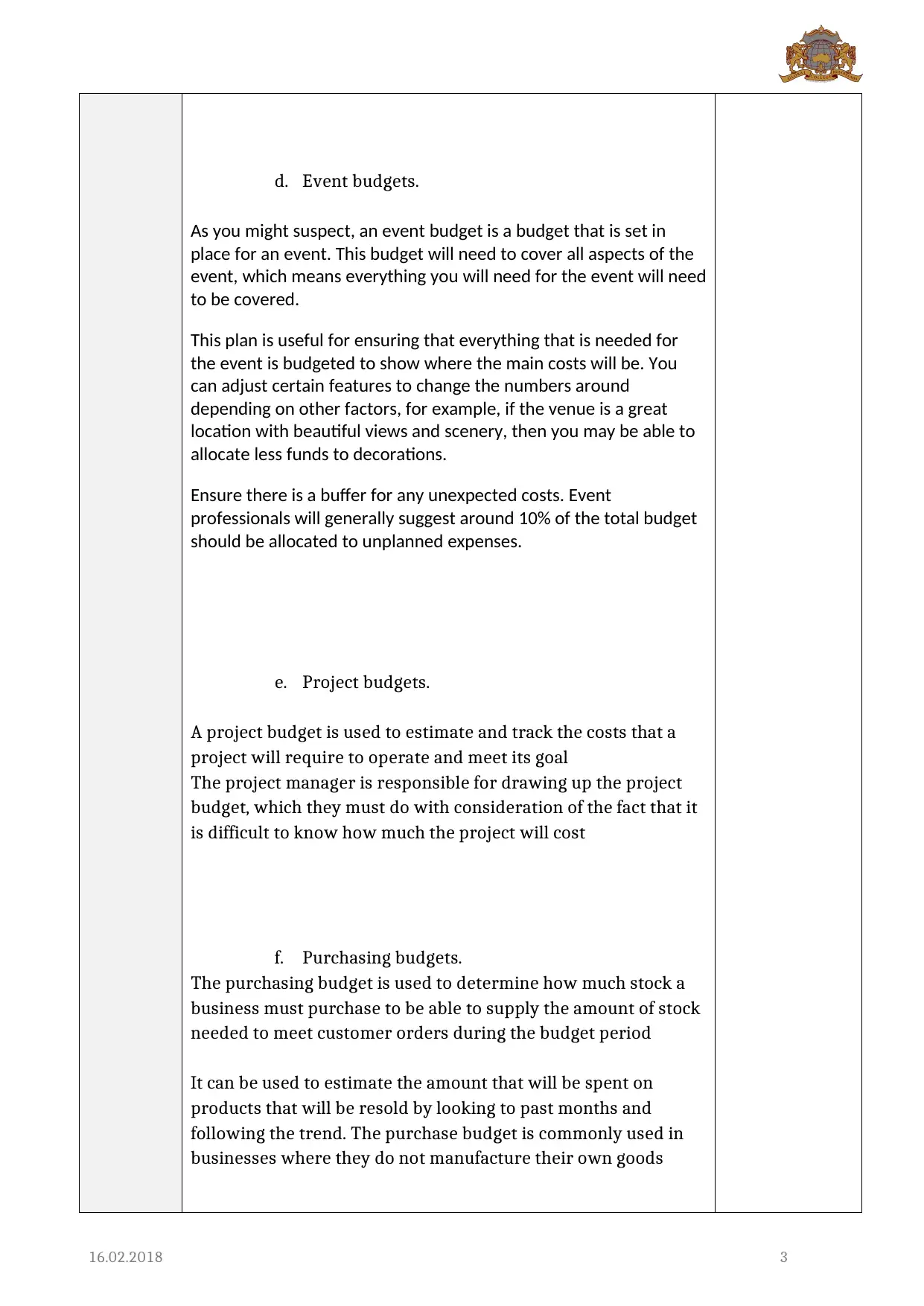
d. Event budgets.
As you might suspect, an event budget is a budget that is set in
place for an event. This budget will need to cover all aspects of the
event, which means everything you will need for the event will need
to be covered.
This plan is useful for ensuring that everything that is needed for
the event is budgeted to show where the main costs will be. You
can adjust certain features to change the numbers around
depending on other factors, for example, if the venue is a great
location with beautiful views and scenery, then you may be able to
allocate less funds to decorations.
Ensure there is a buffer for any unexpected costs. Event
professionals will generally suggest around 10% of the total budget
should be allocated to unplanned expenses.
e. Project budgets.
A project budget is used to estimate and track the costs that a
project will require to operate and meet its goal
The project manager is responsible for drawing up the project
budget, which they must do with consideration of the fact that it
is difficult to know how much the project will cost
f. Purchasing budgets.
The purchasing budget is used to determine how much stock a
business must purchase to be able to supply the amount of stock
needed to meet customer orders during the budget period
It can be used to estimate the amount that will be spent on
products that will be resold by looking to past months and
following the trend. The purchase budget is commonly used in
businesses where they do not manufacture their own goods
16.02.2018 3
As you might suspect, an event budget is a budget that is set in
place for an event. This budget will need to cover all aspects of the
event, which means everything you will need for the event will need
to be covered.
This plan is useful for ensuring that everything that is needed for
the event is budgeted to show where the main costs will be. You
can adjust certain features to change the numbers around
depending on other factors, for example, if the venue is a great
location with beautiful views and scenery, then you may be able to
allocate less funds to decorations.
Ensure there is a buffer for any unexpected costs. Event
professionals will generally suggest around 10% of the total budget
should be allocated to unplanned expenses.
e. Project budgets.
A project budget is used to estimate and track the costs that a
project will require to operate and meet its goal
The project manager is responsible for drawing up the project
budget, which they must do with consideration of the fact that it
is difficult to know how much the project will cost
f. Purchasing budgets.
The purchasing budget is used to determine how much stock a
business must purchase to be able to supply the amount of stock
needed to meet customer orders during the budget period
It can be used to estimate the amount that will be spent on
products that will be resold by looking to past months and
following the trend. The purchase budget is commonly used in
businesses where they do not manufacture their own goods
16.02.2018 3
Paraphrase This Document
Need a fresh take? Get an instant paraphrase of this document with our AI Paraphraser
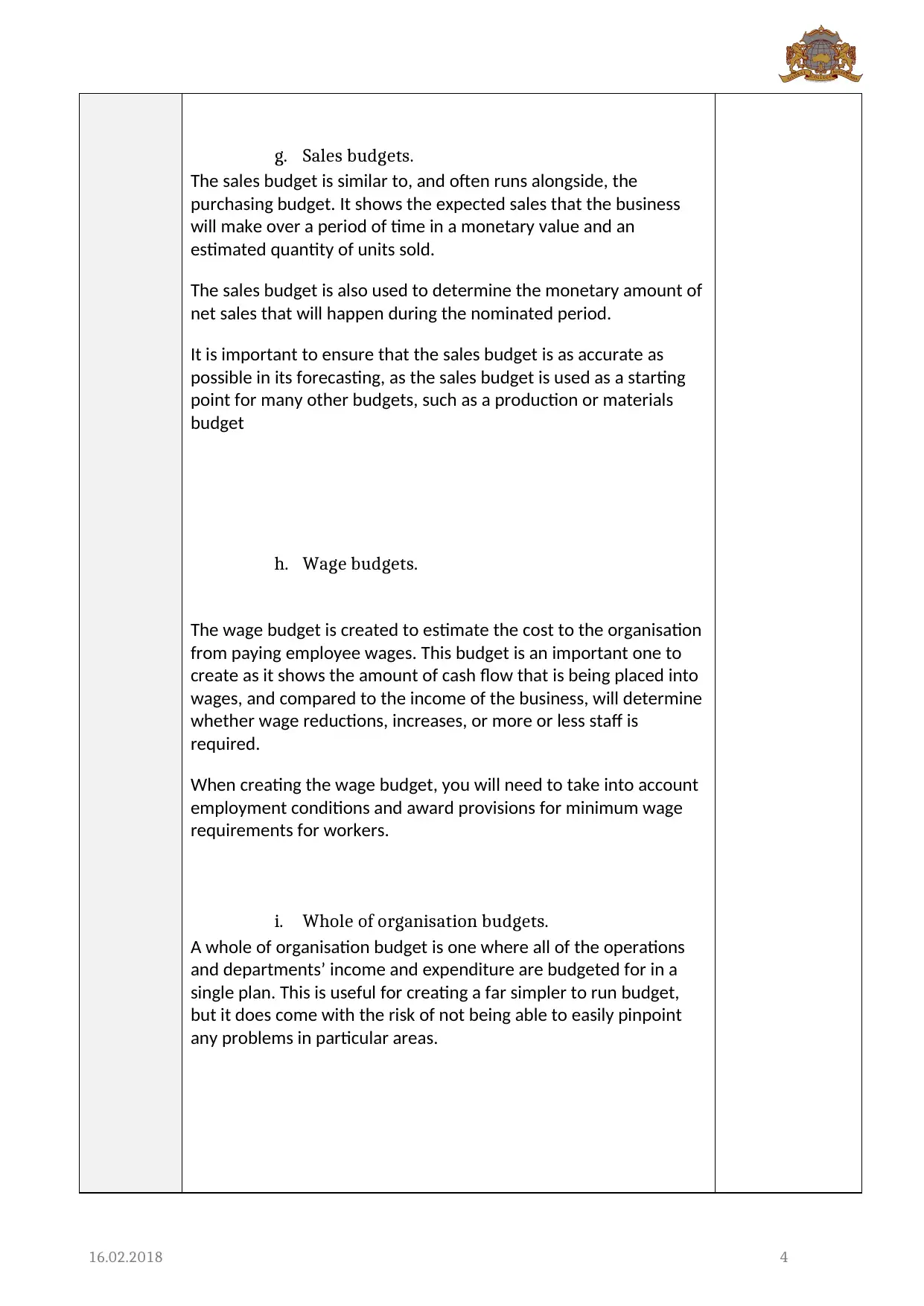
g. Sales budgets.
The sales budget is similar to, and often runs alongside, the
purchasing budget. It shows the expected sales that the business
will make over a period of time in a monetary value and an
estimated quantity of units sold.
The sales budget is also used to determine the monetary amount of
net sales that will happen during the nominated period.
It is important to ensure that the sales budget is as accurate as
possible in its forecasting, as the sales budget is used as a starting
point for many other budgets, such as a production or materials
budget
h. Wage budgets.
The wage budget is created to estimate the cost to the organisation
from paying employee wages. This budget is an important one to
create as it shows the amount of cash flow that is being placed into
wages, and compared to the income of the business, will determine
whether wage reductions, increases, or more or less staff is
required.
When creating the wage budget, you will need to take into account
employment conditions and award provisions for minimum wage
requirements for workers.
i. Whole of organisation budgets.
A whole of organisation budget is one where all of the operations
and departments’ income and expenditure are budgeted for in a
single plan. This is useful for creating a far simpler to run budget,
but it does come with the risk of not being able to easily pinpoint
any problems in particular areas.
16.02.2018 4
The sales budget is similar to, and often runs alongside, the
purchasing budget. It shows the expected sales that the business
will make over a period of time in a monetary value and an
estimated quantity of units sold.
The sales budget is also used to determine the monetary amount of
net sales that will happen during the nominated period.
It is important to ensure that the sales budget is as accurate as
possible in its forecasting, as the sales budget is used as a starting
point for many other budgets, such as a production or materials
budget
h. Wage budgets.
The wage budget is created to estimate the cost to the organisation
from paying employee wages. This budget is an important one to
create as it shows the amount of cash flow that is being placed into
wages, and compared to the income of the business, will determine
whether wage reductions, increases, or more or less staff is
required.
When creating the wage budget, you will need to take into account
employment conditions and award provisions for minimum wage
requirements for workers.
i. Whole of organisation budgets.
A whole of organisation budget is one where all of the operations
and departments’ income and expenditure are budgeted for in a
single plan. This is useful for creating a far simpler to run budget,
but it does come with the risk of not being able to easily pinpoint
any problems in particular areas.
16.02.2018 4
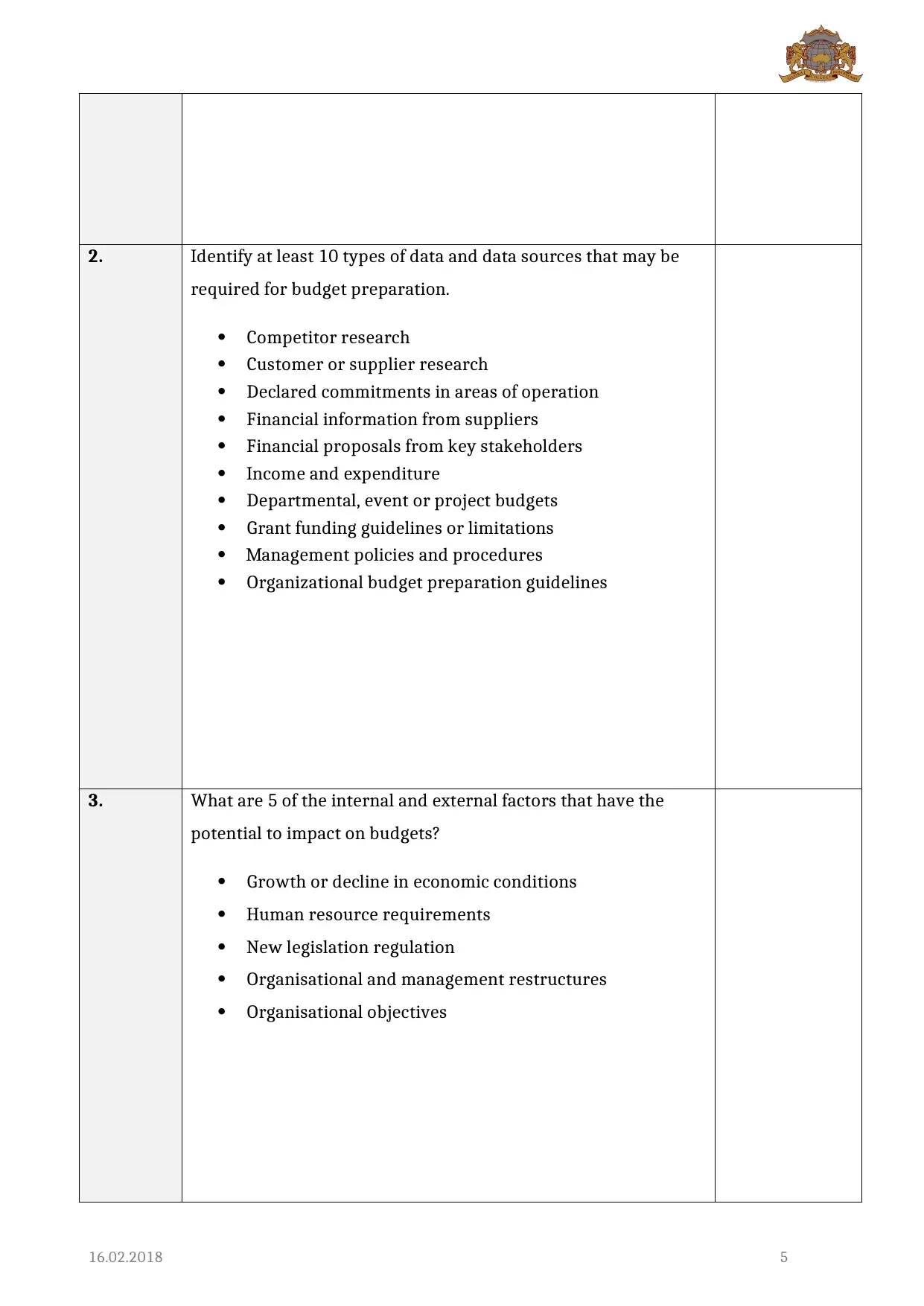
2. Identify at least 10 types of data and data sources that may be
required for budget preparation.
Competitor research
Customer or supplier research
Declared commitments in areas of operation
Financial information from suppliers
Financial proposals from key stakeholders
Income and expenditure
Departmental, event or project budgets
Grant funding guidelines or limitations
Management policies and procedures
Organizational budget preparation guidelines
3. What are 5 of the internal and external factors that have the
potential to impact on budgets?
Growth or decline in economic conditions
Human resource requirements
New legislation regulation
Organisational and management restructures
Organisational objectives
16.02.2018 5
required for budget preparation.
Competitor research
Customer or supplier research
Declared commitments in areas of operation
Financial information from suppliers
Financial proposals from key stakeholders
Income and expenditure
Departmental, event or project budgets
Grant funding guidelines or limitations
Management policies and procedures
Organizational budget preparation guidelines
3. What are 5 of the internal and external factors that have the
potential to impact on budgets?
Growth or decline in economic conditions
Human resource requirements
New legislation regulation
Organisational and management restructures
Organisational objectives
16.02.2018 5
⊘ This is a preview!⊘
Do you want full access?
Subscribe today to unlock all pages.

Trusted by 1+ million students worldwide
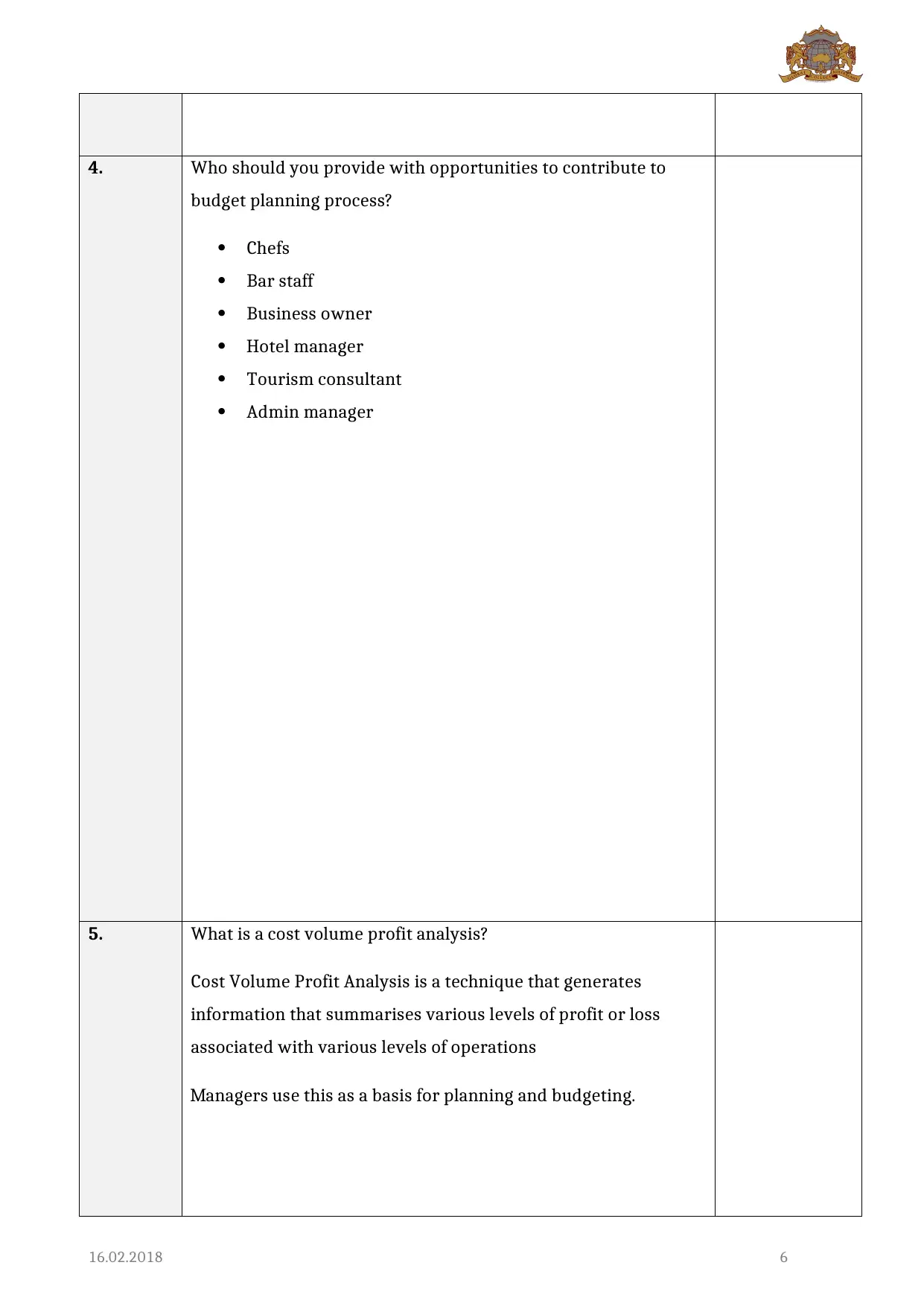
4. Who should you provide with opportunities to contribute to
budget planning process?
Chefs
Bar staff
Business owner
Hotel manager
Tourism consultant
Admin manager
5. What is a cost volume profit analysis?
Cost Volume Profit Analysis is a technique that generates
information that summarises various levels of profit or loss
associated with various levels of operations
Managers use this as a basis for planning and budgeting.
16.02.2018 6
budget planning process?
Chefs
Bar staff
Business owner
Hotel manager
Tourism consultant
Admin manager
5. What is a cost volume profit analysis?
Cost Volume Profit Analysis is a technique that generates
information that summarises various levels of profit or loss
associated with various levels of operations
Managers use this as a basis for planning and budgeting.
16.02.2018 6
Paraphrase This Document
Need a fresh take? Get an instant paraphrase of this document with our AI Paraphraser
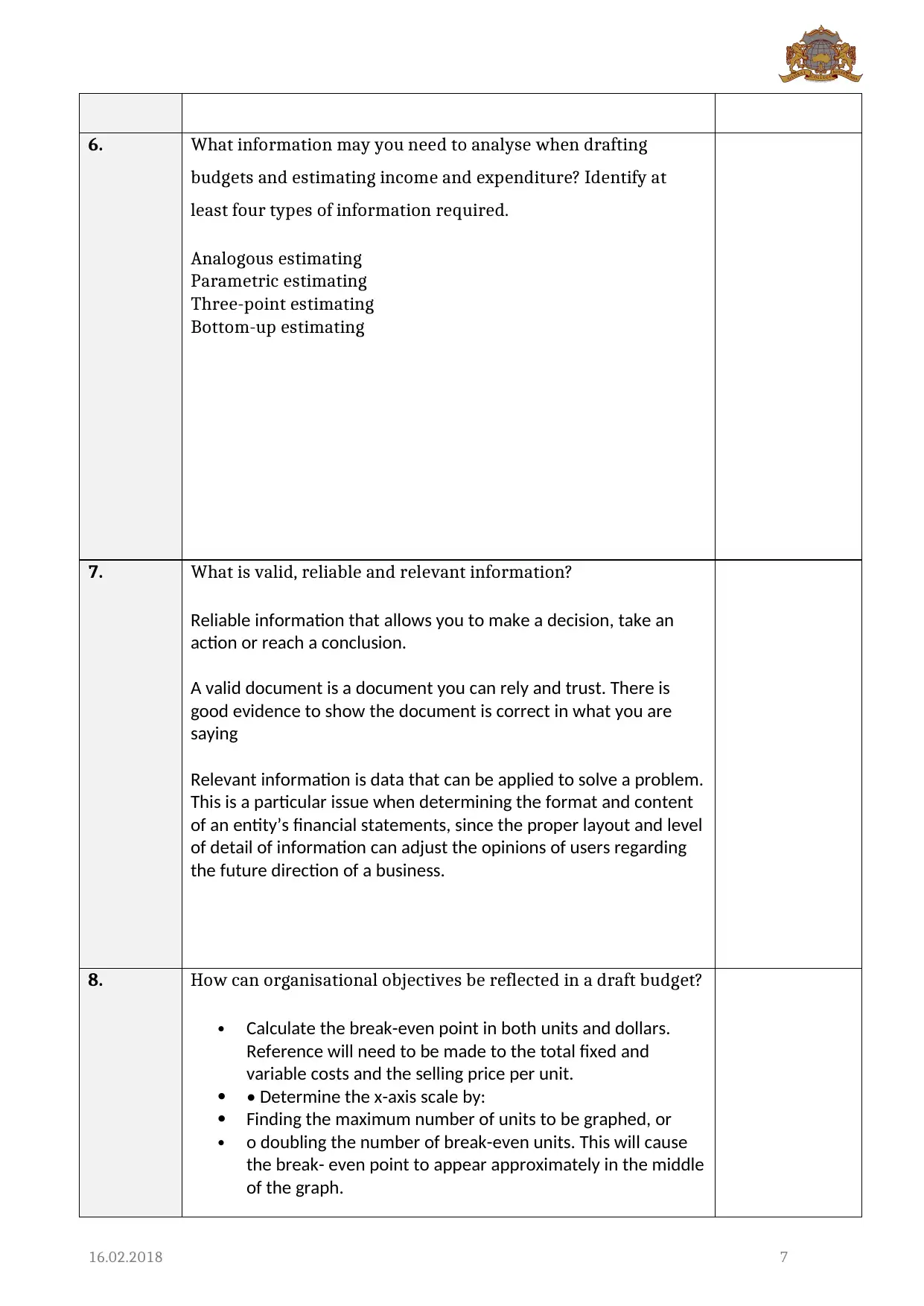
6. What information may you need to analyse when drafting
budgets and estimating income and expenditure? Identify at
least four types of information required.
Analogous estimating
Parametric estimating
Three-point estimating
Bottom-up estimating
7. What is valid, reliable and relevant information?
Reliable information that allows you to make a decision, take an
action or reach a conclusion.
A valid document is a document you can rely and trust. There is
good evidence to show the document is correct in what you are
saying
Relevant information is data that can be applied to solve a problem.
This is a particular issue when determining the format and content
of an entity’s financial statements, since the proper layout and level
of detail of information can adjust the opinions of users regarding
the future direction of a business.
8. How can organisational objectives be reflected in a draft budget?
Calculate the break-even point in both units and dollars.
Reference will need to be made to the total fixed and
variable costs and the selling price per unit.
• Determine the x-axis scale by:
Finding the maximum number of units to be graphed, or
o doubling the number of break-even units. This will cause
the break- even point to appear approximately in the middle
of the graph.
16.02.2018 7
budgets and estimating income and expenditure? Identify at
least four types of information required.
Analogous estimating
Parametric estimating
Three-point estimating
Bottom-up estimating
7. What is valid, reliable and relevant information?
Reliable information that allows you to make a decision, take an
action or reach a conclusion.
A valid document is a document you can rely and trust. There is
good evidence to show the document is correct in what you are
saying
Relevant information is data that can be applied to solve a problem.
This is a particular issue when determining the format and content
of an entity’s financial statements, since the proper layout and level
of detail of information can adjust the opinions of users regarding
the future direction of a business.
8. How can organisational objectives be reflected in a draft budget?
Calculate the break-even point in both units and dollars.
Reference will need to be made to the total fixed and
variable costs and the selling price per unit.
• Determine the x-axis scale by:
Finding the maximum number of units to be graphed, or
o doubling the number of break-even units. This will cause
the break- even point to appear approximately in the middle
of the graph.
16.02.2018 7
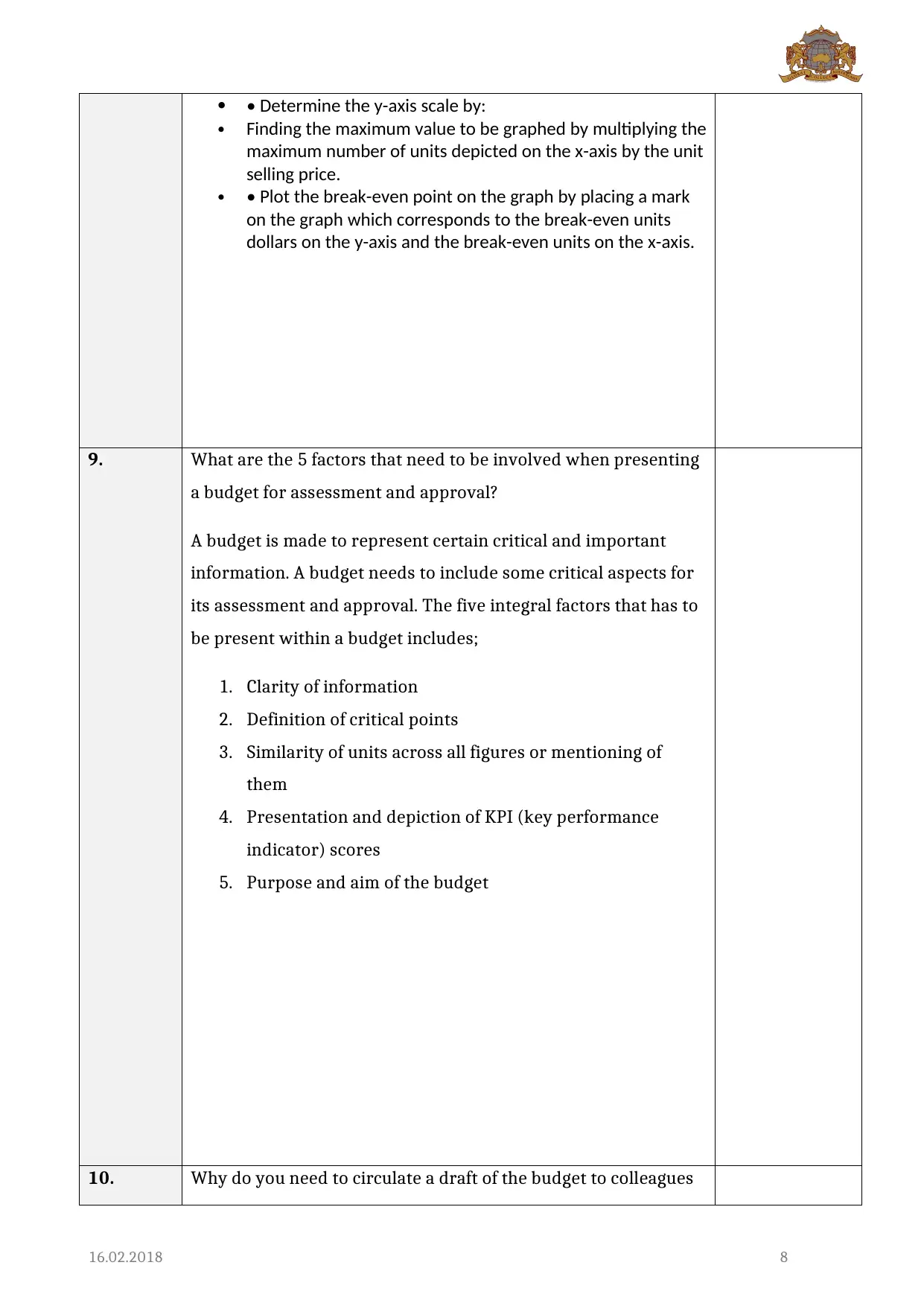
• Determine the y-axis scale by:
Finding the maximum value to be graphed by multiplying the
maximum number of units depicted on the x-axis by the unit
selling price.
• Plot the break-even point on the graph by placing a mark
on the graph which corresponds to the break-even units
dollars on the y-axis and the break-even units on the x-axis.
9. What are the 5 factors that need to be involved when presenting
a budget for assessment and approval?
A budget is made to represent certain critical and important
information. A budget needs to include some critical aspects for
its assessment and approval. The five integral factors that has to
be present within a budget includes;
1. Clarity of information
2. Definition of critical points
3. Similarity of units across all figures or mentioning of
them
4. Presentation and depiction of KPI (key performance
indicator) scores
5. Purpose and aim of the budget
10. Why do you need to circulate a draft of the budget to colleagues
16.02.2018 8
Finding the maximum value to be graphed by multiplying the
maximum number of units depicted on the x-axis by the unit
selling price.
• Plot the break-even point on the graph by placing a mark
on the graph which corresponds to the break-even units
dollars on the y-axis and the break-even units on the x-axis.
9. What are the 5 factors that need to be involved when presenting
a budget for assessment and approval?
A budget is made to represent certain critical and important
information. A budget needs to include some critical aspects for
its assessment and approval. The five integral factors that has to
be present within a budget includes;
1. Clarity of information
2. Definition of critical points
3. Similarity of units across all figures or mentioning of
them
4. Presentation and depiction of KPI (key performance
indicator) scores
5. Purpose and aim of the budget
10. Why do you need to circulate a draft of the budget to colleagues
16.02.2018 8
⊘ This is a preview!⊘
Do you want full access?
Subscribe today to unlock all pages.

Trusted by 1+ million students worldwide
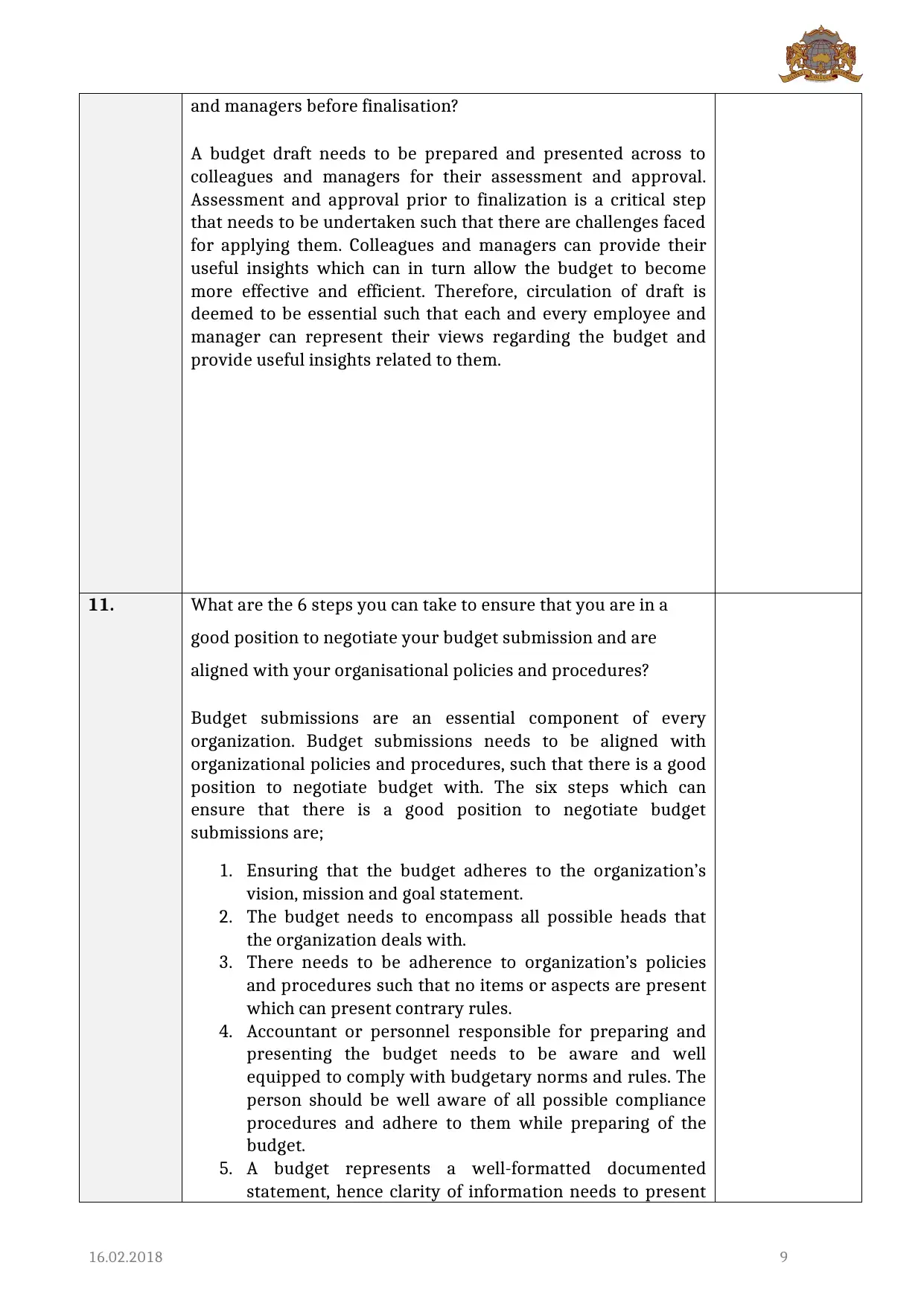
and managers before finalisation?
A budget draft needs to be prepared and presented across to
colleagues and managers for their assessment and approval.
Assessment and approval prior to finalization is a critical step
that needs to be undertaken such that there are challenges faced
for applying them. Colleagues and managers can provide their
useful insights which can in turn allow the budget to become
more effective and efficient. Therefore, circulation of draft is
deemed to be essential such that each and every employee and
manager can represent their views regarding the budget and
provide useful insights related to them.
11. What are the 6 steps you can take to ensure that you are in a
good position to negotiate your budget submission and are
aligned with your organisational policies and procedures?
Budget submissions are an essential component of every
organization. Budget submissions needs to be aligned with
organizational policies and procedures, such that there is a good
position to negotiate budget with. The six steps which can
ensure that there is a good position to negotiate budget
submissions are;
1. Ensuring that the budget adheres to the organization’s
vision, mission and goal statement.
2. The budget needs to encompass all possible heads that
the organization deals with.
3. There needs to be adherence to organization’s policies
and procedures such that no items or aspects are present
which can present contrary rules.
4. Accountant or personnel responsible for preparing and
presenting the budget needs to be aware and well
equipped to comply with budgetary norms and rules. The
person should be well aware of all possible compliance
procedures and adhere to them while preparing of the
budget.
5. A budget represents a well-formatted documented
statement, hence clarity of information needs to present
16.02.2018 9
A budget draft needs to be prepared and presented across to
colleagues and managers for their assessment and approval.
Assessment and approval prior to finalization is a critical step
that needs to be undertaken such that there are challenges faced
for applying them. Colleagues and managers can provide their
useful insights which can in turn allow the budget to become
more effective and efficient. Therefore, circulation of draft is
deemed to be essential such that each and every employee and
manager can represent their views regarding the budget and
provide useful insights related to them.
11. What are the 6 steps you can take to ensure that you are in a
good position to negotiate your budget submission and are
aligned with your organisational policies and procedures?
Budget submissions are an essential component of every
organization. Budget submissions needs to be aligned with
organizational policies and procedures, such that there is a good
position to negotiate budget with. The six steps which can
ensure that there is a good position to negotiate budget
submissions are;
1. Ensuring that the budget adheres to the organization’s
vision, mission and goal statement.
2. The budget needs to encompass all possible heads that
the organization deals with.
3. There needs to be adherence to organization’s policies
and procedures such that no items or aspects are present
which can present contrary rules.
4. Accountant or personnel responsible for preparing and
presenting the budget needs to be aware and well
equipped to comply with budgetary norms and rules. The
person should be well aware of all possible compliance
procedures and adhere to them while preparing of the
budget.
5. A budget represents a well-formatted documented
statement, hence clarity of information needs to present
16.02.2018 9
Paraphrase This Document
Need a fresh take? Get an instant paraphrase of this document with our AI Paraphraser

such that all relevant stakeholders can read it. Clarity of
information needs to be present for all relevant
stakeholders, such that they can easily comprehend the
same and thereafter approve it.
6. A budget for the purpose of getting approval need to
contain clear reasons for allocation into different
budgetary heads such that they are self-explanatory in
nature. Clarity of information represents necessary
grounds on which everyone can easily accept and no one
can reject the budget or such that minim um alterations
are needed for changing the budget.
12. Why might you need to agree on and incorporate modifications
into the budget?
A budget after its presentation might require certain changes to
be made. Incorporating modification into the budget is generally
made to include views and aspects of relevant stakeholders.
While some changes can be incorporated into others might have
to be rejected at the face off it. Incorporation of modification into
the budget primarily includes changes in budgetary heads,
creating additional provisions, inclusion of KPI scores and so on.
These changes made into the budget are primarily aimed at
improvising of the budget and information presented by it. On
the contrary other changes might be not possible to incorporate
as they might include other alterations to be made into
budgetary heads and so on.
13. What format must be the final budget is in?
The final budget format has to be in Ms Excel or similar other
16.02.2018 10
information needs to be present for all relevant
stakeholders, such that they can easily comprehend the
same and thereafter approve it.
6. A budget for the purpose of getting approval need to
contain clear reasons for allocation into different
budgetary heads such that they are self-explanatory in
nature. Clarity of information represents necessary
grounds on which everyone can easily accept and no one
can reject the budget or such that minim um alterations
are needed for changing the budget.
12. Why might you need to agree on and incorporate modifications
into the budget?
A budget after its presentation might require certain changes to
be made. Incorporating modification into the budget is generally
made to include views and aspects of relevant stakeholders.
While some changes can be incorporated into others might have
to be rejected at the face off it. Incorporation of modification into
the budget primarily includes changes in budgetary heads,
creating additional provisions, inclusion of KPI scores and so on.
These changes made into the budget are primarily aimed at
improvising of the budget and information presented by it. On
the contrary other changes might be not possible to incorporate
as they might include other alterations to be made into
budgetary heads and so on.
13. What format must be the final budget is in?
The final budget format has to be in Ms Excel or similar other
16.02.2018 10
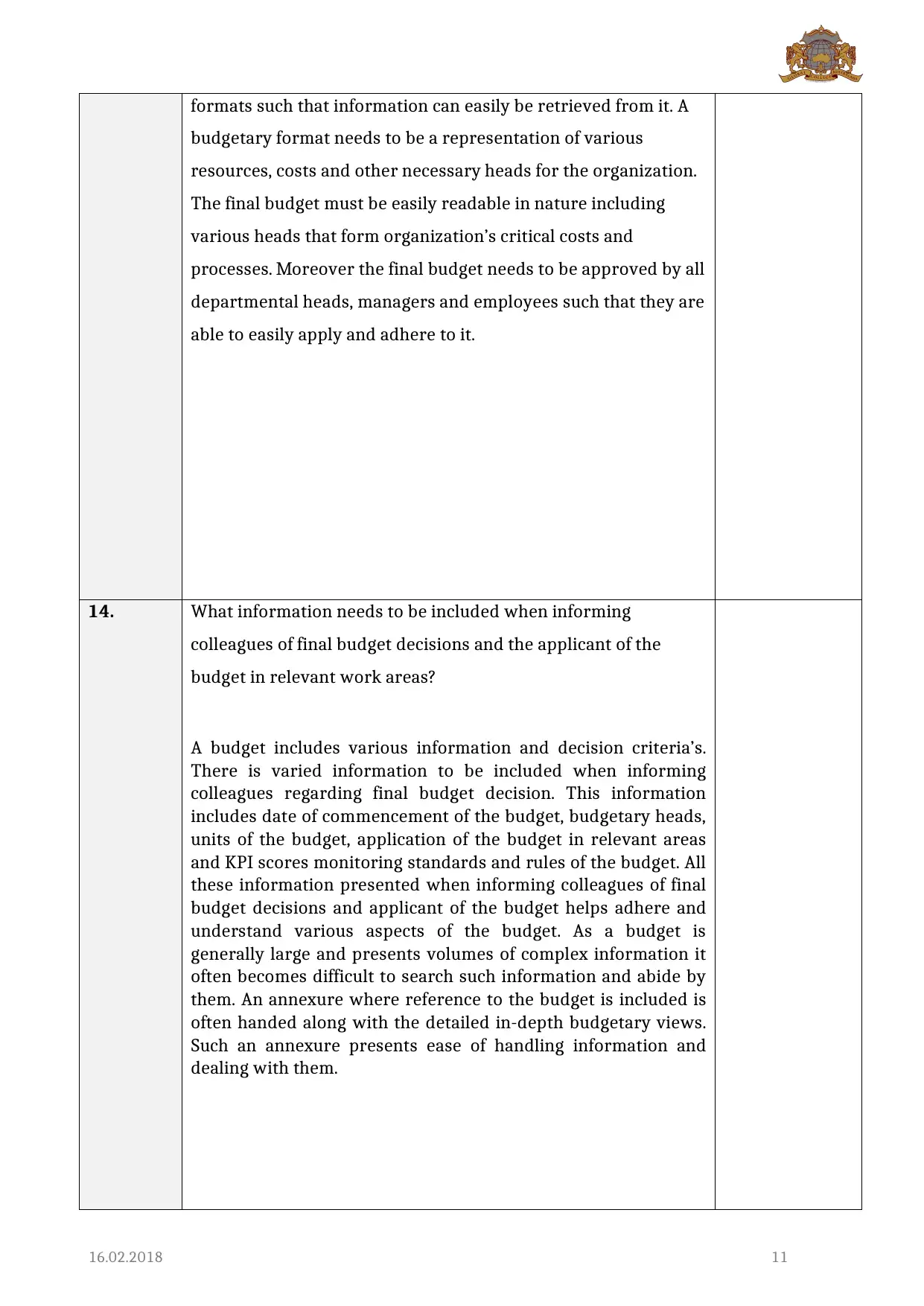
formats such that information can easily be retrieved from it. A
budgetary format needs to be a representation of various
resources, costs and other necessary heads for the organization.
The final budget must be easily readable in nature including
various heads that form organization’s critical costs and
processes. Moreover the final budget needs to be approved by all
departmental heads, managers and employees such that they are
able to easily apply and adhere to it.
14. What information needs to be included when informing
colleagues of final budget decisions and the applicant of the
budget in relevant work areas?
A budget includes various information and decision criteria’s.
There is varied information to be included when informing
colleagues regarding final budget decision. This information
includes date of commencement of the budget, budgetary heads,
units of the budget, application of the budget in relevant areas
and KPI scores monitoring standards and rules of the budget. All
these information presented when informing colleagues of final
budget decisions and applicant of the budget helps adhere and
understand various aspects of the budget. As a budget is
generally large and presents volumes of complex information it
often becomes difficult to search such information and abide by
them. An annexure where reference to the budget is included is
often handed along with the detailed in-depth budgetary views.
Such an annexure presents ease of handling information and
dealing with them.
16.02.2018 11
budgetary format needs to be a representation of various
resources, costs and other necessary heads for the organization.
The final budget must be easily readable in nature including
various heads that form organization’s critical costs and
processes. Moreover the final budget needs to be approved by all
departmental heads, managers and employees such that they are
able to easily apply and adhere to it.
14. What information needs to be included when informing
colleagues of final budget decisions and the applicant of the
budget in relevant work areas?
A budget includes various information and decision criteria’s.
There is varied information to be included when informing
colleagues regarding final budget decision. This information
includes date of commencement of the budget, budgetary heads,
units of the budget, application of the budget in relevant areas
and KPI scores monitoring standards and rules of the budget. All
these information presented when informing colleagues of final
budget decisions and applicant of the budget helps adhere and
understand various aspects of the budget. As a budget is
generally large and presents volumes of complex information it
often becomes difficult to search such information and abide by
them. An annexure where reference to the budget is included is
often handed along with the detailed in-depth budgetary views.
Such an annexure presents ease of handling information and
dealing with them.
16.02.2018 11
⊘ This is a preview!⊘
Do you want full access?
Subscribe today to unlock all pages.

Trusted by 1+ million students worldwide
1 out of 28
Related Documents
Your All-in-One AI-Powered Toolkit for Academic Success.
+13062052269
info@desklib.com
Available 24*7 on WhatsApp / Email
![[object Object]](/_next/static/media/star-bottom.7253800d.svg)
Unlock your academic potential
Copyright © 2020–2025 A2Z Services. All Rights Reserved. Developed and managed by ZUCOL.





